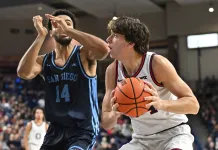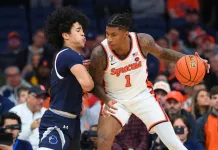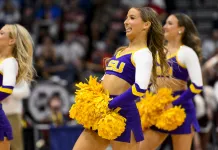West Coast Conference
Gonzaga and Saint Mary’s are the two programs that garner the most respect from the West Coast Conference. The Bulldogs are NCAA Tournament regulars who find themselves in the Sweet 16 and beyond year after year under Mark Few. Randy Bennett almost always fields a competitive team, and he has won at least 20 games each season but one since 2008.
But do not be fooled; the West Coast Conference is deep.
San Francisco has won at least 20 games in seven of the last eight seasons, and it most recently made the NCAA Tournament in 2022. Santa Clara has quietly become an NBA hub, producing first round selections in two of the last three drafts. The Broncos were also a bettor’s best friend last season, finishing with a league-best 18-12-2 ATS (60%) record.
This conference also got deeper in the offseason. Due to the chaos of conference realignment, the two Pac-12 castoffs – Washington State and Oregon State – are now honorary members of the WCC. They can win the regular season title, and are listed on oddsboards to do so. Their presence only makes a sneaky deep league even deeper.
Having said that, there are some very poor programs here.
Pacific was the worst cover team in the country last season at 6-24 ATS (20%). It failed to cover on average by 8.3 points per game; also the worst mark in the country. Pepperdine has not won more than 15 games in the last four seasons. Portland is well-coached with Shantay Legans, but it is rebuilding once more.
Speaking of, there are quite a few great coaches in this league outside of Few and Bennett. Herb Sendek (Santa Clara), Chris Gerlufsen (San Francisco) and Wayne Tinkle (Oregon State) to name a few.
At the end of the day, this conference runs through the Bulldogs, and Gonzaga looks like a national title contender once again. But, Gonzaga has some stiff competition this season, and this could be a multi-bid league once again.
Gonzaga Bulldogs
Four starters are back from the team that made a Sweet 16 run last season. Gonzaga was the fifth-best offensive team in the country by efficiency standards (122.6). With three double-digit scorers from last season – Ryan Nembhard, Nolan Hickman and Graham Ike – back in the fold this team should be one of the most prolific offenses in the country again. If Gonzaga were to improve in any one facet it, it would be on defense. The Bulldogs ranked 51st in defensive efficiency (99.4) and 201st in opponent 3-point shooting. Still, they were the second-best defense in the WCC and are strong enough to deserve the status of odds-on favorite (-225) to win the conference.
The new face in the fold is Arkansas transfer Khalif Battle (14.8 PPG). He’s a sixth-year senior with good size that should fit well next to Nembhard (12.6 PPG) and Hickman (41.3% 3P%). Those two form one of the best backcourts in the country. Nembhard (12.6 PPG) was 65th in the country in assist rate last season. Up front, Ike might be one of the best low post players in the game. Last season, this program was supposed to be down. Instead they made a tournament run. This season, there are warranted expectations for the Bulldogs.
Loyola Marymount Lions
Loyola Marymount was an extremely poor team last season. It went 12-19 SU/12-18-1 ATS for the season and just 5-11 SU in conference play. Injuries did play a role, but so, too, did poor play. This season, the Lions are set up to improve. Two of five double-digit scorers are back. Head coach Stan Johnson dipped into the transfer portal and landed some really solid pieces as well. The Lions are stronger up front and along the wing this season. They could be a plucky team early before the market catches up to the improvements this team has made.
The biggest name Johnson landed is former Pepperdine forward Jevon Porter (16.2 PPG, 5.9 RPG), who is an electric scorer. Alex Merkviladze is one of the two returning double-digit scorers for the Lions. He is 6-foot-8 and a 35.2% shooter. Porter and Markviladze give LMU two solid wing players that will be a handful for opponents to defend. Will Johnston (11.1 PPG) was a 37.5% shooter. Those three should help the Lions maintain their strong shooting from last season. Rick Issanza is a massive 7-foot-1 center which gives LMU a legit rim protector. There is also plenty of depth to this roster with the additions in the portal.
Oregon State Beavers
Oregon State’s roster was demolished in the offseason. Two of the program’s best players – Jordan Pope and Tyler Bilodeau – transferred to other programs. Five others – including a third double-digit scorer in Dexter Akanno – left as well. Wayne Tinkle was forced to rebuild through the transfer portal. Despite that, the Beavers should be at least on par with the group that finished 13-19 SU/16-14 ATS.
The key piece for Tinkle and Oregon State will be Michael Rataj. The 6-foot-9 forward averaged 8.3 points and 5.8 rebounds. He is a strong rebounder who grabbed 18.1% of defensive rebounds. Rataj also has the ability to space the floor despite shooting just 28.8% from deep. Where the production comes from around Rataj is a question. Parsa Fallah (13.2 PPG, 6.0 RPG) is a 6-foot-9 forward from Southern Utah and Matthew Marsh – a 7-foot-1 transfer from Wake Forest – will round out the frontcourt for Tinkle. Demarco Minor (15.5 PPG, 8.5 RPG) comes in from SIUE to run the show after a strong season. Those four form a strong core for Oregon State to build on. Tinkle loves to play at a slow pace with an emphasis on rebounding and this group should allow him to do just that.
Pacific Tigers
Pacific was one of the worst teams in the country last season. The Tigers finished 6-26 SU/6-24-2 ATS with a -8.3 spread differential. They lost on average by 15.1 points per game and dropped the last 17 games of the season. Usually there is nowhere to go but up for such a moribund program, but that is not likely the case for Pacific this season. All five starters from last season are gone. Transfers from Division I, Division II and JUCOs around the country round out this roster. Dave Smart – a former Texas Tech assistant – has his work cut out for him without a doubt.
Smart brings 6-foot-4 guard Lamar Washington (2.1 PPG, 1.5 RPG) with him from Lubbock. He played in 30 games last season for the Red Raiders, so his experience at such a high level should work wonders as he leads a program at a lower level. Jefferson Koulibaly (SMU) and Elijah Fisher (DePaul) are another pair of transfers. Of the two, Fisher is the big get, as he averaged 10.2 points on 52.0% shooting from the floor. The Tigers will likely not be the pure bet-against team they were last season, but this team still figures to be one of the lowest-rated teams in the country this season.
Pepperdine Waves
Ed Schilling takes over a Pepperdine program which saw two of its best players – Michael Ajayi and Houston Mallette – depart for greener pastures. Overall, the entire starting five from last season is gone. But, thanks to a strong transfer class the Waves might hit the ground running in Schilling’s first season at the helm.
Aaron Clark is the most intriguing transfer. From Wake Forest, Clark is a former four-star recruit that played in just seven games last season. Grad transfer Alonso Faure – who stands at 6-foot-10 – projects to be a starting option at center. Marist transfer Javon Cooley is a 38.3% shooter. Moe Odum played in the WCC for Pacific and knows the conference well. He ranked 17th in the country in assist rate (35.5%). Schilling also has some really intriguing freshmen who could play big roles this season. A name to monitor will be Jaxon Olvera (19 PPG, 6 RPG, 5 APG) for Golden State Prep in Oakland. The other youngster is Taj Au-Duke who averaged a whopping 24.8 points for CALI Prep in Canada. KenPom projects six WCC wins for Pepperdine, but this team could push for a few more if the freshmen get off to strong starts.
Portland Pilots
Portland is a young team this season. Seven of the scholarship players for Shantay Legans are either redshirt freshmen or true freshmen. There are some old heads on the roster, but everything out of Portland is that this season is about growth and improvement. That will likely lead to some ugly results, in hopes that the bumps taken lead to good results in the future.
Vukasin Masic (12.5 PPG, 4.2 RPG, 2.9 APG) is one of the seniors on this roster and shot 40.3% from deep. Chris Austin – the other senior – averaged 6.8 points and shot 36.5% from beyond the arc. Max Mackinnon (12.1 PPG, 4.8 RPG) transferred in from Elon. Of the youngsters bettors should track, Bol Dengdit is one of the most important. Dengdit is a 6-foot-10 center who ranked 14th in defensive rebounding rate and ninth in offensive rebounding rate in the WCC last season. Vincent Delano and Kelson Gebbers – a pair of redshirt freshmen – figure to play large roles at point guard and along the wing. Portland has usually been a somewhat quick team with a poor defense under Legans. With so many young pieces, that is exactly what this version of Portland projects to be this season.
Saint Mary’s Gaels
Death, taxes and an underrated Saint Mary’s basketball team. That seems to be the case once again, as Randy Bennett enters the regular season as the second choice to win the West Coast Conference. Bennett brings back two starters from a team that won the WCC Tournament but lost to Grand Canyon in the first round of the NCAA Tournament. The Gaels went 17-1 SU/12-6 ATS against WCC opponents. Would it really shock anyone if St. Mary’s dominated the conference once again this season?
Augustas Marciulionis (12.4 PPG, 3.3 RPG, 5.3 APG) is back after a breakout season in which he won WCC Player of the Year. Returning with Marciulionis is the WCC Defensive Player of the Year, Mitchell Saxen. Saxen (11.8 PPG, 7.6 RPG, 1.3 BPG) is a 6-foot-10 center who was also the conference’s third-best offensive rebounder (13.2%). Harry Wessels is a 7-foot-1 center who could play with Saxen and give the Gaels a nearly impenetrable front line. The backcourt is the biggest issue with this roster. Jordan Ross (1.3 PPG) and Luke Barrett (5.5 PPG) figure to take on more, but are largely untested. Regardless, given the strength up front and the track record of Bennett, this team is going to be a formidable foe for Gonzaga once again.
San Diego Toreros
San Diego improved its record from the first to the second season under Steve Lavin. However, Lavin lost four of his starting five from last season. Lavin must now work with a group built on talented sophomores like Dragos Lungu and Keyon Kensie. There are a few key transfers brought in as well, but the Toreros season will go as the youth does this season.
Lungu (5.1 PPG, 2.6 RPG) assisted on 19.2% of baskets when he was on the floor, and showed some improvement in international play over the summer. Kensie showed some flashes last season, including a 16-point and six-rebound outburst in the final game of the season against Santa Clara in the WCC Tournament. Don’t forget about leading returning scorer Steven Jamerson (8.3 PPG, 8.1 RPG). There are also quite a few freshmen that figure to play massive roles. Jackson Gaffey is a 6-foot-6 wing that gives the Toreros length along the perimeter. Chas Lewless, if healthy (back), projects to get time at guard. One transfer to monitor: Division II transfer Kody Clouet averaged 17.6 points and 5.1 rebounds at Southeastern Oklahoma State. Lavin has some talent to work with and has a good track record of developing young players. This team shouldn’t take a massive step back this season.
San Francisco Dons
Chris Gerlufsen has done a tremendous job in two seasons at San Francisco. He has won 43 games in two seasons, and the Dons finished third in the WCC and went 12-6 SU/8-10 ATS against conference foes. San Francisco has three starters back and a team primed to push the powers at the top of the WCC for a spot at the table.
Marcus Williams is the Dons’ lead man. Williams averaged 14.0 points, 3.3 rebounds and 3.9 assists on his way toward a first team all-conference selection. A great lead guard, Williams ranked sixth in the WCC in assist rate (23.7%) and eighth in steal rate (2.5%). Malik Thomas is a 6-foot-5 wing player who averaged 12.4 points and shot 40.0% from deep. Ndewedo Newbury averaged 9.4 points and 3.7 rebounds. He finished 36th in the country in true shooting percentage. Then there is sophomore Ryan Beasley who won WCC Freshman of the Year after averaging 7.8 points per game. Despite the losses there is an argument to make that this group is better than last season, and at +1200 there is real value in this team winning the regular season WCC title.
Santa Clara Broncos
Santa Clara was the best WCC team to bet on last season. The Broncos went 20-13 SU/18-12-2 ATS, and they finished 13-4-1 ATS against WCC opponents. Herb Sendek had this team playing some of the best defense in the league, and it finished with the best perimeter defense in the WCC. Three starters and a good chunk of their production return this season, meaning the Broncos are ready to build on an extremely strong year.
The lead returner for Santa Clara is former Arizona transfer Adama-Alpha Bal. Bal (14.4 PPG, 3.2 RPG, 3.1 APG) was 14th in the WCC in usage rate and will be the focal point of this offense once again. Johnny O’Neil averaged 11.0 points and 5.5 rebounds and returns to play up front for the Broncos. He was ninth in the WCC in blocks with 25 total. Tyeree Bryan will likely have a larger role after averaging 8.2 points and 3.8 rebounds in 32 games last season as well. Sendek also has depth at center with Christoph Tilly returning after a strong season in which he put up 9.4 points and 4.6 rebounds per game.
Washington State Cougars
Washington State is rebuilding. All five starters from last season are gone, and only one scholarship player from that team remains. David Riley comes in after three seasons with Eastern Washington with a tall task. Riley won 31 conference games over the last two seasons with the Eagles. To speed up the process in Pullman, he brought the core of that team with him.
Cedric Crawford (15.4 PPG) is a 6-foot-6 senior who averaged 15.4 points per game. Dane Erikstrup is a 6-foot-11 big man who averaged 10.8 points and 3.3 rebounds. Ethan Price is 6-foot-10 and can stretch the floor. LeJuan Watts (9.4 PPG, 4.9 RPG) averaged 9.4 points and 4.9 rebounds for Riley as well. That quartet brings size, length and experience for Washington State. Riley’s teams were some of the fastest in the country, and his offensive approach will be easily implemented with a group of players who have been in it the last few years. The Cougars might replicate the 25 wins from last season, but they won’t be as poor as teams that are in similar situations usually are.






